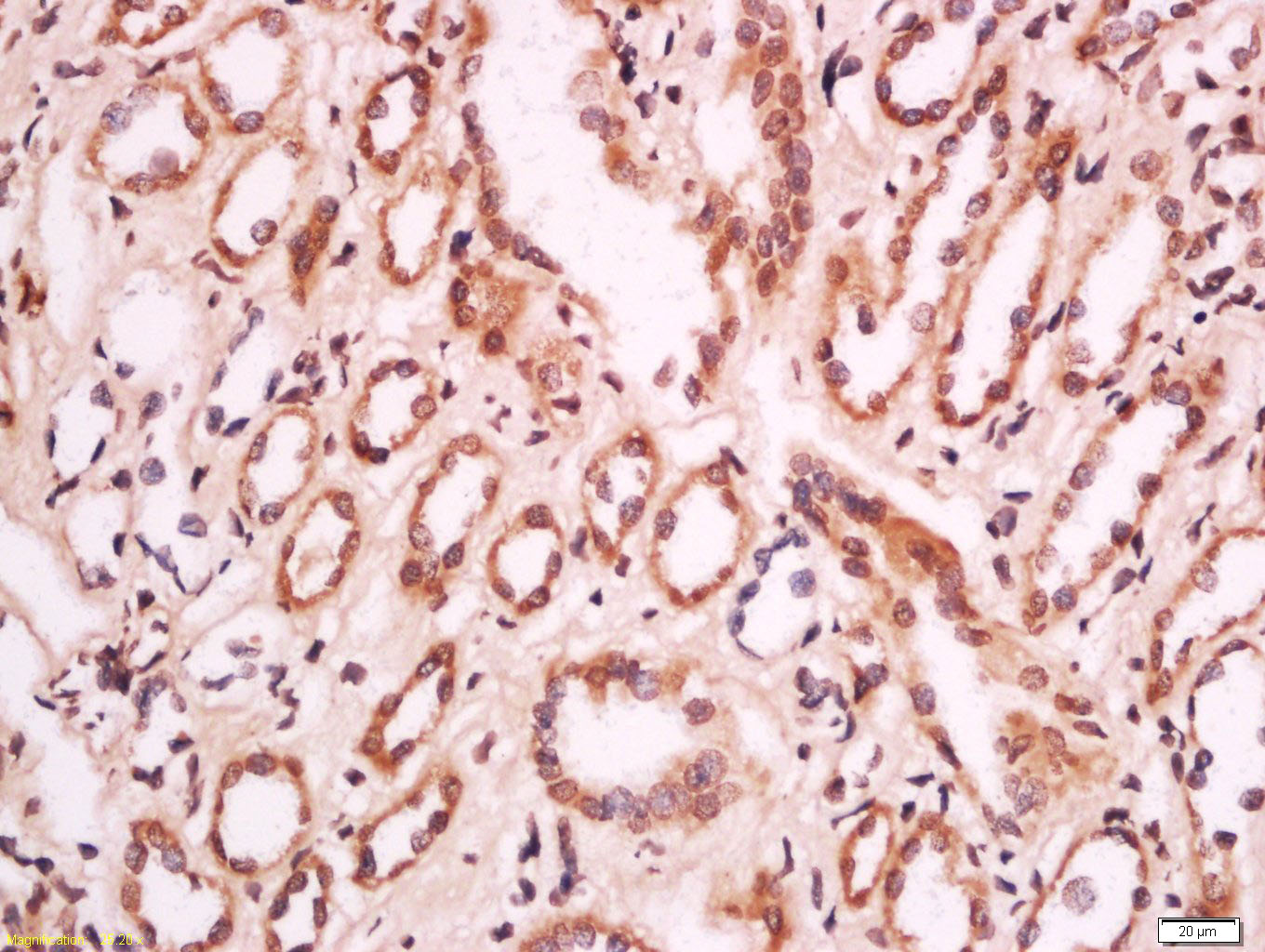
Rabbit Anti-MELK antibody
AI327312; HPK38; hMELK; HPK 38; hPK38; KIAA0175; Likely ortholog of maternal embryonic leucine zipper kinase; Maternal embryonic leucine zipper kinase; MELK; MELK_HUMAN; mKIAA0175; MPK38; OTTHUMP00000021377; OTTHUMP00000046113; pEg3 kinase; Protein kinase
View History [Clear]
Details
Product Name MELK Chinese Name 蛋白激酶MPK38抗体 Alias AI327312; HPK38; hMELK; HPK 38; hPK38; KIAA0175; Likely ortholog of maternal embryonic leucine zipper kinase; Maternal embryonic leucine zipper kinase; MELK; MELK_HUMAN; mKIAA0175; MPK38; OTTHUMP00000021377; OTTHUMP00000046113; pEg3 kinase; Protein kinase PK38; RP23 382O11.1. literatures Research Area Cell biology Developmental biology Signal transduction Stem cells Kinases and Phosphatases Immunogen Species Rabbit Clonality Polyclonal React Species Human, (predicted: Mouse, Rat, Dog, Pig, Cow, Horse, Rabbit, Sheep, ) Applications ELISA=1:5000-10000 IHC-P=1:100-500 IHC-F=1:100-500 ICC=1:100-500 IF=1:100-500 (Paraffin sections need antigen repair)
not yet tested in other applications.
optimal dilutions/concentrations should be determined by the end user.Theoretical molecular weight 75kDa Cellular localization cytoplasmic Form Liquid Concentration 1mg/ml immunogen KLH conjugated synthetic peptide derived from Human MELK/HPK38: 101-250/651 Lsotype IgG Purification affinity purified by Protein A Buffer Solution 0.01M TBS(pH7.4) with 1% BSA, 0.03% Proclin300 and 50% Glycerol. Storage Shipped at 4℃. Store at -20 °C for one year. Avoid repeated freeze/thaw cycles. Attention This product as supplied is intended for research use only, not for use in human, therapeutic or diagnostic applications. PubMed PubMed Product Detail MELK a new member of the Snf1/AMPK family of kinases, encodes a protein with a kinase catalytic domain and a leucine zipper motif consisting of a periodic repetition of leucine residues at every seventh residue located within the N-terminal catalytic domain. This motif has been observed in myriad DNA-binding proteins and is presumed to be involved in protein-DNA interactions, and potentially protein-protein interactions. Research predicts that the gene product of MELK plays a role in the signal transduction events in the egg and early embryo. Mouse and human MELK proteins share 95% sequence identity in the kinase domain and northern blot analysis in mouse indicates that MELK expression is restricted to spermatogonia in the testis and to oocytes in the ovary.
Function:
Phosphorylates ZNF622 and may contribute to its redirection to the nucleus. May be involved in the inhibition of spliceosome assembly during mitosis.
Subunit:
Monomer. Interacts with ZNF622 and PPP1R8.
Subcellular Location:
Cytoplasm.
Tissue Specificity:
Expressed in placenta, kidney, thymus, testis, ovary and intestine.
Post-translational modifications:
Autophosphorylated. Thr-478 phosphorylation during mitosis promotes interaction with PPP1R8.
DISEASE:
Note=Defects in MELK are associated with some cancers, such as brain or breast cancers. Expression is dramatically increased in aggressive undifferentiated tumors, correlating with poor patient outcome in breast and brain cancers, suggesting a role in tumor-initiating cells and proliferation via its function in cell proliferation regulation.
Similarity:
Belongs to the protein kinase superfamily.
CAMK Ser/Thr protein kinase family. SNF1 subfamily.
Contains 1 KA1 (kinase-associated) domain.
Contains 1 protein kinase domain.
SWISS:
Q14680
Gene ID:
9833
Database links:Entrez Gene: 9833 Human
Entrez Gene: 17279 Mouse
Omim: 607025 Human
SwissProt: Q14680 Human
SwissProt: Q61846 Mouse
Unigene: 184339 Human
Unigene: 268668 Mouse
Product Picture
Antigen retrieval: citrate buffer ( 0.01M, pH 6.0 ), Boiling bathing for 15min; Block endogenous peroxidase by 3% Hydrogen peroxide for 30min; Blocking buffer (normal goat serum,C-0005) at 37℃ for 20 min;
Incubation: Anti-MELK Polyclonal Antibody, Unconjugated(SL12201R) 1:200, overnight at 4°C, followed by conjugation to the secondary antibody(SP-0023) and DAB(C-0010) staining
Bought notes(bought amounts latest0)
No one bought this product
User Comment(Total0User Comment Num)
- No comment



 +86 571 56623320
+86 571 56623320
 +86 18668110335
+86 18668110335

